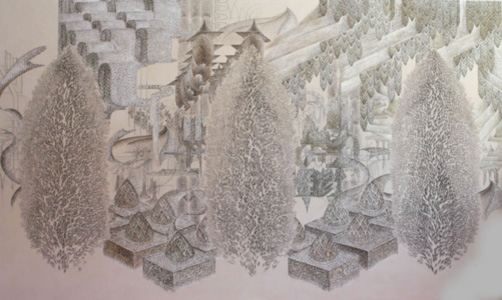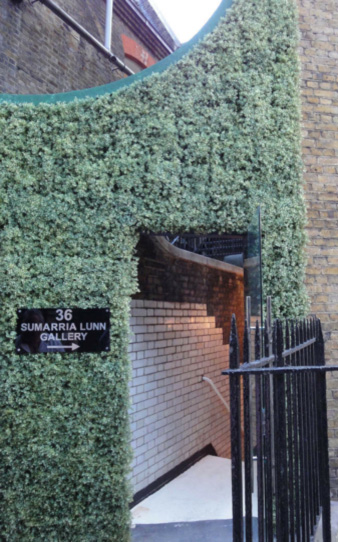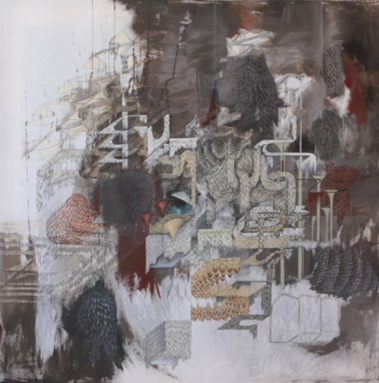
whitehot | May 2011, Yun-Kyung Jeong @ Sumarria Lunn

Yun-Kyung Jeong, Constructing Jungle, 2010
Acrylic on cotton, 250x150cm.
Courtesy, the artist and Sumarria Lunn
Yun-Kyung Jeong: Axonometric
Sumarria Lunn
36 South Molton Lane, London W1
11 May through 4 June, 2011
Tucked away amongst the hallowed spaces of Gray’s Antiques on South Molton Lane in central London, Sumarria Lunn’s first permanent gallery space is an eccentric visual feast. Visitors are welcomed by a cascade of vivid vegetation clinging to the wall surrounding an entrance of narrow stairs flanked by ceramic white and untreated rough brick surfaces. Past the chic vintage chandelier it becomes clear that 36 South Molton Lane is no white cube. A converted underground warehouse space, the gallery’s biggest strength is also its vulnerability, as the double corridor of shallow arches demands a sharply inventive curatorial initiative to ensure any show, regardless of scale, is displayed to its best advantage.

Sumarria Lunn entrance. Photograph by John Bridges
Sumarria Lunn, whose co-founders Will Lunn and Vishal Sumarria (who also founded Young Professionals in the Arts) have been ones to watch on the London art scene for some time. This Mayfair space is their first permanent gallery, and they’ve launched it with Axonometric, a collection of emerging Korean artist Yun-Kyung Jeong’s paintings. Jeong’s large images are executed in a restricted palette of grays, deep reds, olive greens, and earth tones. The occasional mark of vivid blue is strikingly pleasurable amongst these expanses, all of which play on repetition, perspective, depth, and the uncanny comingling of organic forms. Elements within these works accommodate associations of leaves, circulatory systems, an animal’s thick fur, a population of trees in an isolated wood, the complex tubular plumbing beneath urban streets, or accumulations of ruins. This latter possibility is especially suggestive, as it indicates a propensity for transformation, inversion, opening out, and journeying through that seems to invite comparison between Sumarria Lunn’s approach to their idiosyncratic gallery space and Jeong’s approach to the canvas.
Yun-Kyung Jeong is a graduate of Ewha University (Seoul), the Slade School of Fine Art, and Goldsmiths. She has exhibited widely in Korea and the UK and was the recipient of the Renaissance Art Prize and the Foster Fletcher Prize in 2008. She usually paints on unprimed canvas or silk, but is increasingly interested in digital photography and video. Her artwork demonstrates her deep interest in the flow of space and the juxtaposition – and occasionally hybridization – of ambiguous forms. Jeong deploys axonometry by foreshortening planes and overlaying them to create spaces, which are at once beyond reality and charged with three-dimensional possibility. It is as though her flat surfaces simultaneously proclaim and negate their surface qualities.

Yun-Kyung Jeong, Axonometric Jungle, 2010
Acrylic on canvas, 130x90cm.
Courtesy, the artist and Sumarria Lunn
Axonometric Jungle offers the viewer a dense tangle of fluid quadrants in which patterns of flame-like protrusions create wave, cube and pyramid structures that threaten to recede or blend into one another even as they are articulated before the eye. Jeong believes that these droplet markings are fundamental to her practice. “Every mark in my paintings is like a breath,” she explains. “It is like controlled exhalations filling a space…Every single shape looks similar but each has its own energy and direction as they expand across the canvas. I strongly believe that every existence has its own path or direction within the world.” These markings, which are the markings of biological process, mental distillation, and the passage of time, also have an architectural impetus. These elements can be seen as insistent ogee arches, each containing a threshold to a new world within itself. As an architectural historian, I became increasingly curious about the impact of Britain’s Gothic heritage on Jeong since her arrival in London as an art college graduate.

J. M. W. Turner, The Chancel and Crossing of Tintern Abbey, Looking Towards the East Window, 1794
Pencil and watercolour on paper, 36x25cm.
Tate Britain
She explained that she has been inspired by Gothic architectural ruins, and J. M. W. Turner’s Tintern Abbey in particular. Jeong points out that Turner’s attention to “the mysterious mixing of the organic elements within the architecture” connects Gothic structures to the plants that consume them, even as they emphasize the specificity of an ancient building’s fragmented monumental geometry. The Axonometric series andTintern Abbey are perhaps surprisingly comparable, as Jeong felt that the Gothic “heavily references natural forms in combination with the organic weavings of nature” in which she also provocatively locates a meeting of Eastern and Western cultural traditions. Axonometric skewing of perspective is a classic method for conveying depth, and Jeong’s compelling canvases do so in a variety of remarkable ways. This show suggests that we should expect rich offerings from Sumarria Lunn as they make their mark in Mayfair.

Ayla Lepine is a Visiting Lecturer at the Courtauld Institute of Art and Warwick University, where she teaches courses on Victorian art and architecture. Ayla is currently investigating new ways of interpreting space and the body through material culture. She is also a freelance speaker, writer and researcher. Visit Ayla’s blog (www.heartchitecture.wordpress.com) or follow her on Twitter @heartchitecture.
